B-Tg(hLILRB2/hLILRB3/hLILRB1/hLILRB4) mice
| Strain Name | C57BL/6-Tg(RP11-634C1)1(CH17-401N15)1/Bcgen | Common Name | B-Tg(hLILRB2/hLILRB3/hLILRB1/hLILRB4) mice |
| Background | C57BL/6 | Catalog number | 112332 |
|
Related Genes |
LILRB2: ILT4, LIR2, CD85D, ILT-4, LIR-2, MIR10, MIR-10 LILRB3: HL9, ILT5, LIR3, PIRB, CD85A, ILT-5, LIR-3, PIR-B, LILRA6 LILRB1: ILT2, LIR1, MIR7, PIRB, CD85J, ILT-2, LIR-1, MIR-7, PIR-B LILRB4: ILT3, LIR5, CD85K, ILT-3, LIR-5 |
||
LILRB1 expression analysis in B-Tg(hLILRB2/hLILRB3/hLILRB1/hLILRB4) mice (non-tumor bearing)
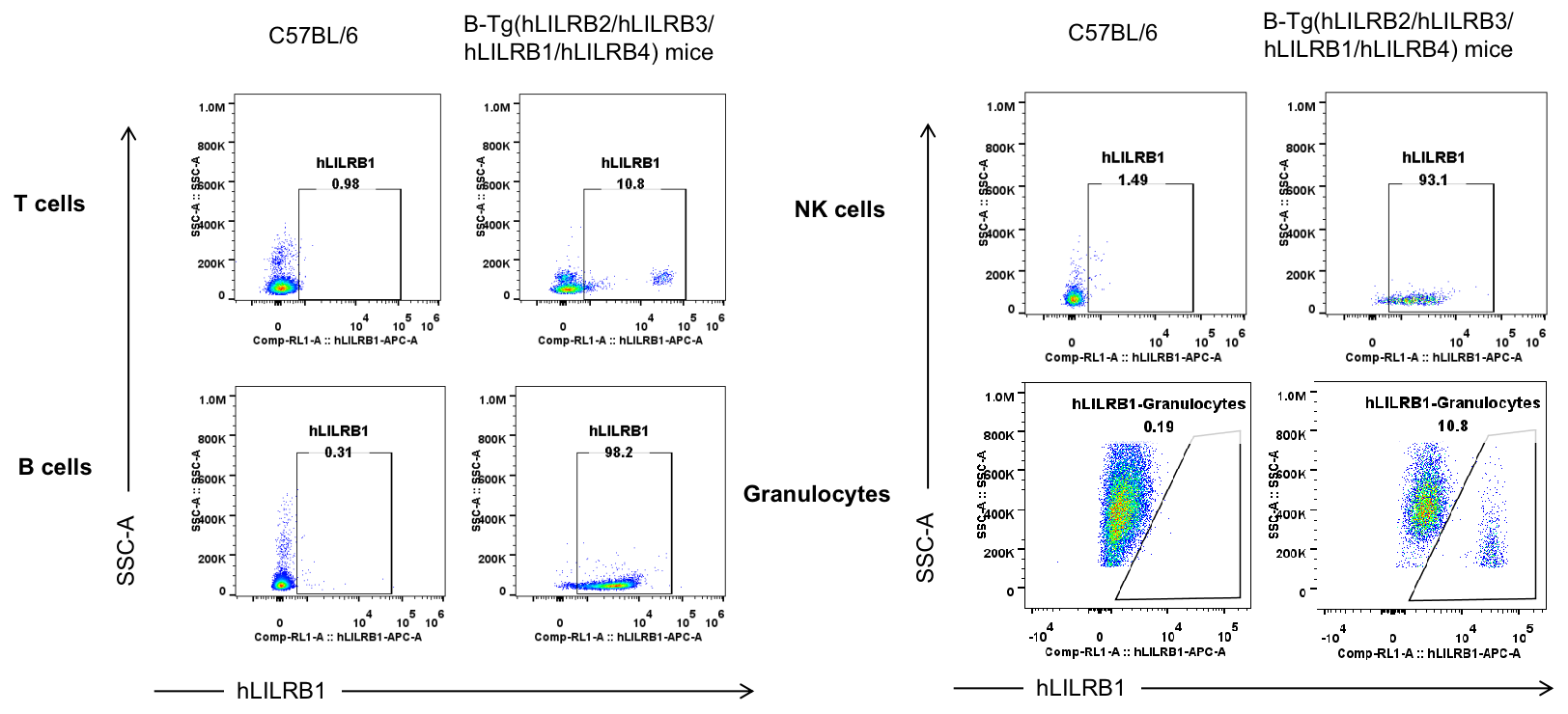
Strain specific hLILRB1 expression analysis in B-Tg(hLILRB2/hLILRB3/hLILRB1/hLILRB4) mice by flow cytometry. Blood were collected from wild-type (+/+) and transgenic B-Tg(hLILRB2/hLILRB3/hLILRB1/hLILRB4) mice (Tg), and analyzed by flow cytometry with species-specific anti-human LILRB1 antibody. Human LILRB1 was both detectable in T cells, B cells, NK cells and granulocytes from B-Tg(hLILRB1/hLILRB4) mice but not wild-type mice.
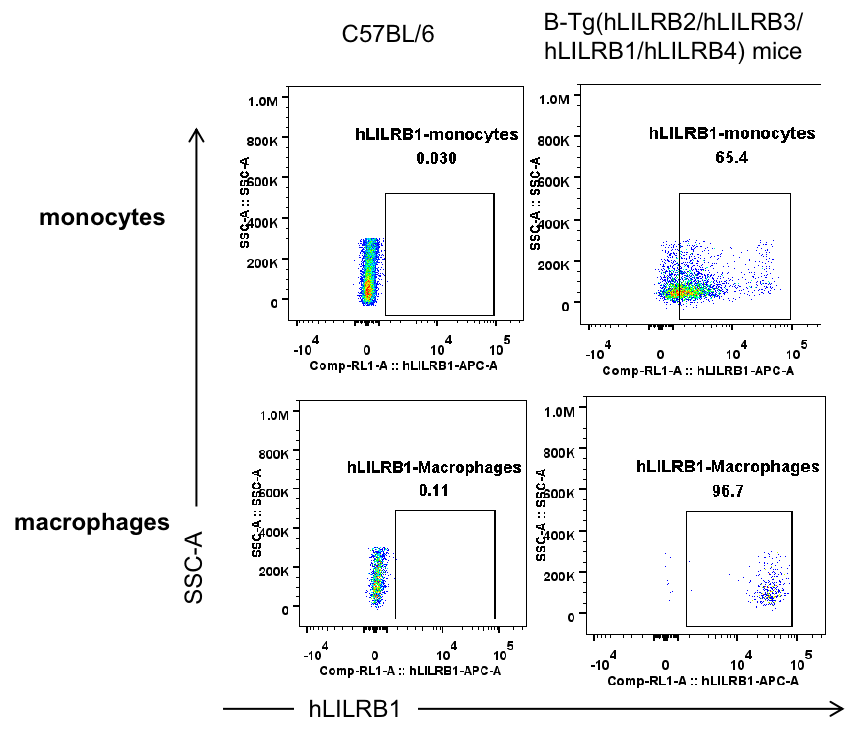
Strain specific hLILRB1 expression analysis in B-Tg(hLILRB2/hLILRB3/hLILRB1/hLILRB4) mice by flow cytometry. Blood were collected from wild-type (+/+) and transgenic B-Tg(hLILRB2/hLILRB3/hLILRB1/hLILRB4) mice (Tg), and analyzed by flow cytometry with species-specific anti-human LILRB1 antibody. Human LILRB1 was both detectable in monocytes and macrophages from B-Tg(hLILRB1/hLILRB4) mice but not wild-type mice.
LILRB2 expression analysis in B-Tg(hLILRB2/hLILRB3/hLILRB1/hLILRB4) mice (non-tumor bearing)
Protein expression analysis
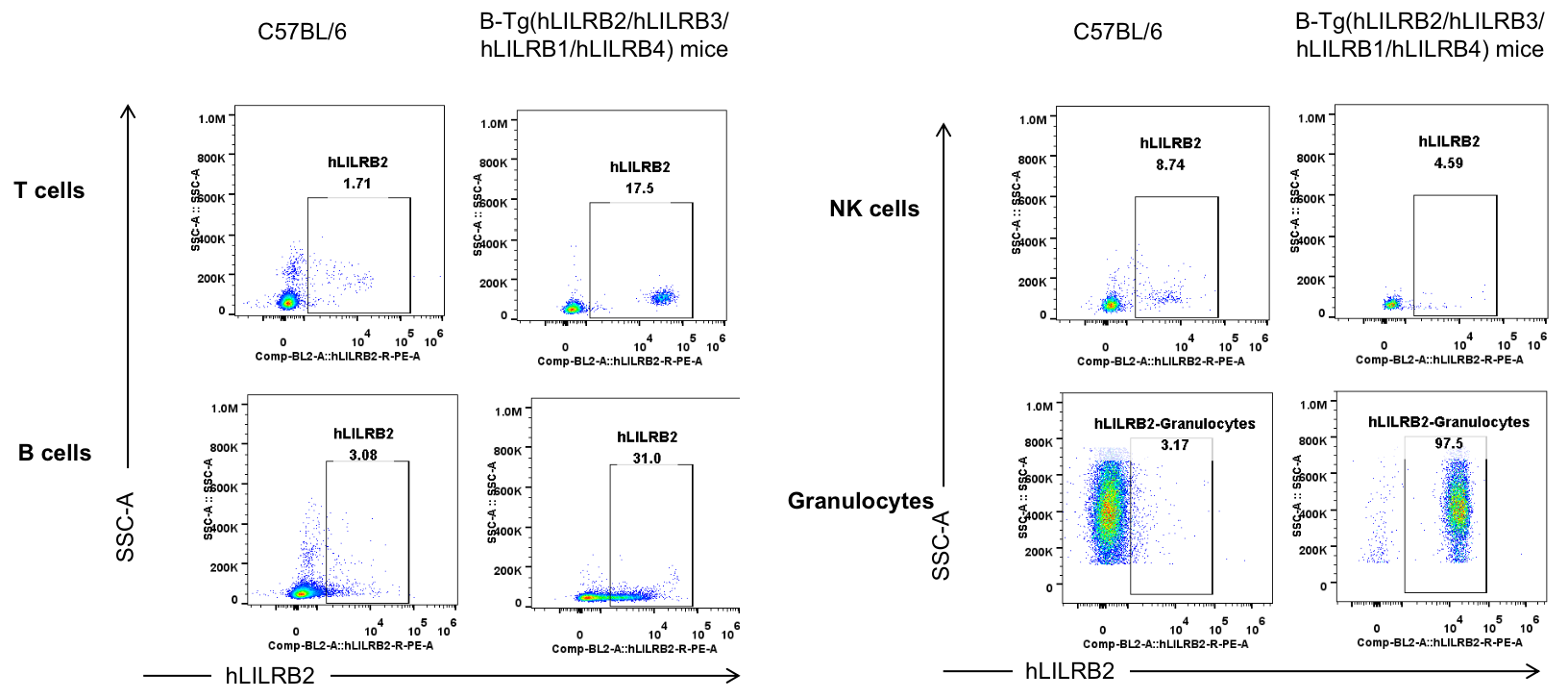
Strain specific hLILRB2 expression analysis in B-Tg(hLILRB2/hLILRB3/hLILRB1/hLILRB4) mice by flow cytometry. Blood were collected from wild-type (+/+) and transgenic B-Tg(hLILRB2/hLILRB3/hLILRB1/hLILRB4) mice (Tg), and analyzed by flow cytometry with species-specific anti-human LILRB2 antibody. Human LILRB2 was both detectable in T cells, B cells, NK cells and granulocytes from B-Tg(hLILRB1/hLILRB4) mice but not wild-type mice.
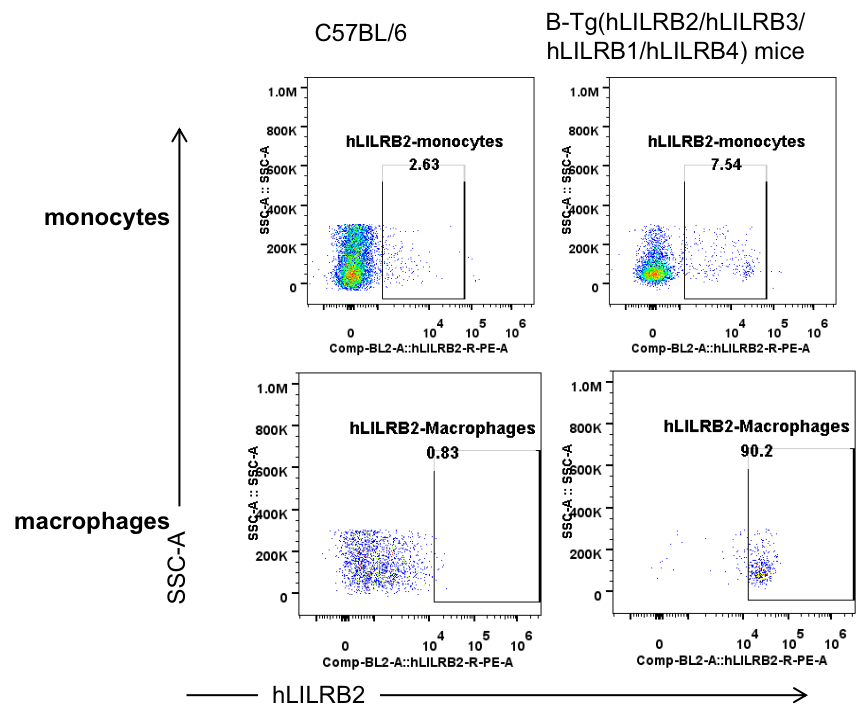
Strain specific hLILRB2 expression analysis in B-Tg(hLILRB2/hLILRB3/hLILRB1/hLILRB4) mice by flow cytometry. Blood were collected from wild-type (+/+) and transgenic B-Tg(hLILRB2/hLILRB3/hLILRB1/hLILRB4) mice (Tg), and analyzed by flow cytometry with species-specific anti-human LILRB2 antibody. Human LILRB2 was both detectable in monocytes and macrophages from B-Tg(hLILRB1/hLILRB4) mice but not wild-type mice.
LILRB3 expression analysis in B-Tg(hLILRB2/hLILRB3/hLILRB1/hLILRB4) mice (non-tumor bearing)
Protein expression analysis
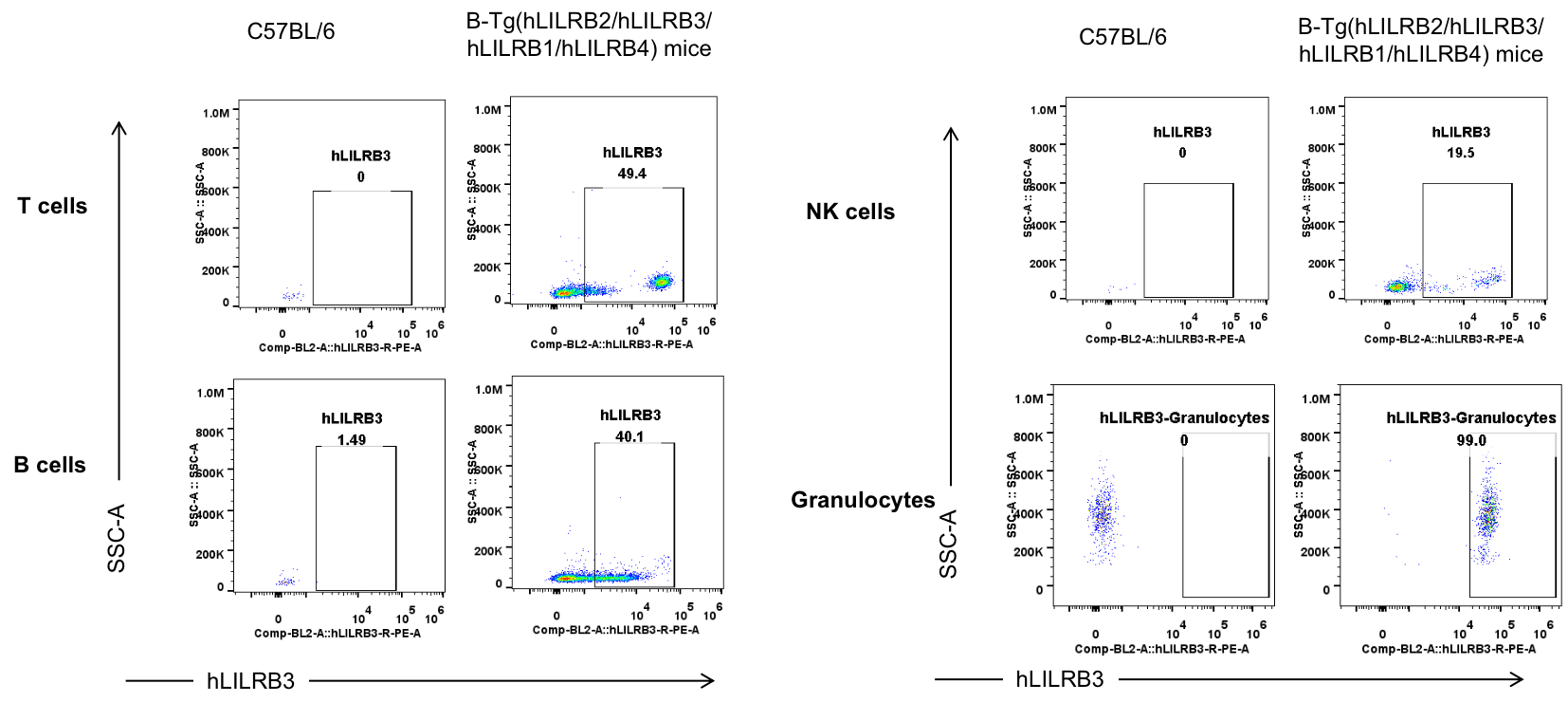
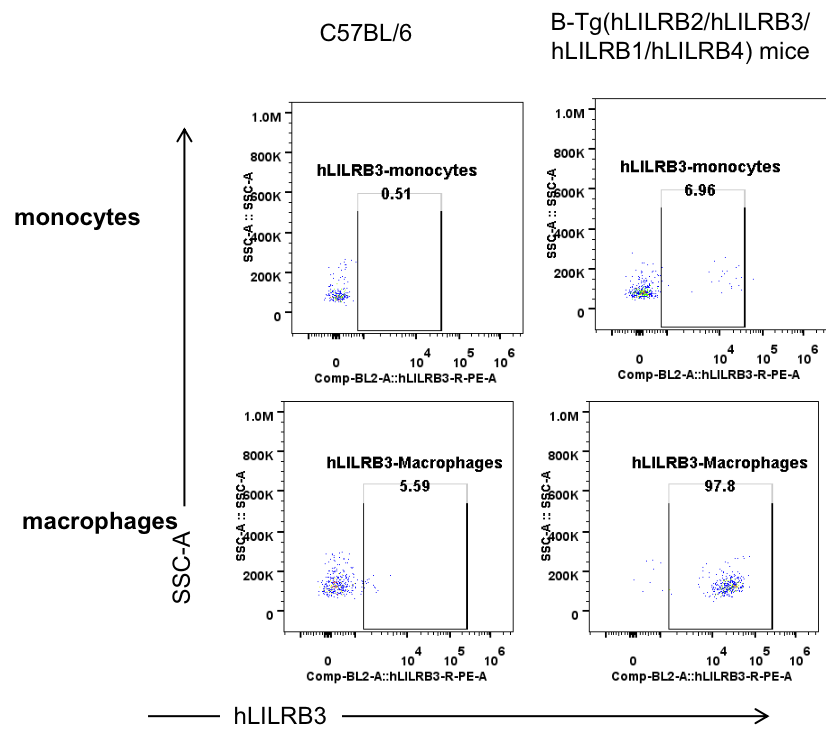
LILRB4 expression analysis in B-Tg(hLILRB2/hLILRB3/hLILRB1/hLILRB4) mice (non-tumor bearing)
Protein expression analysis
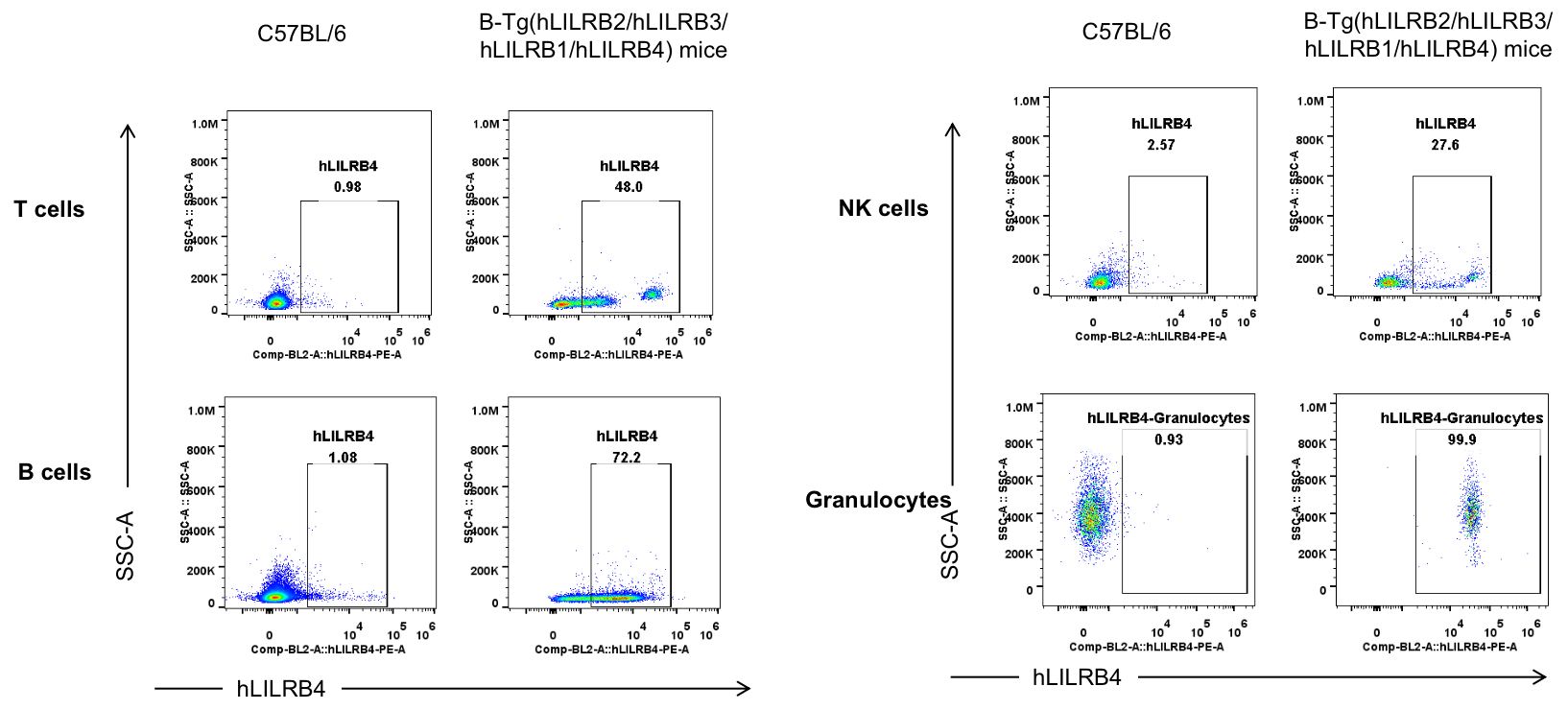
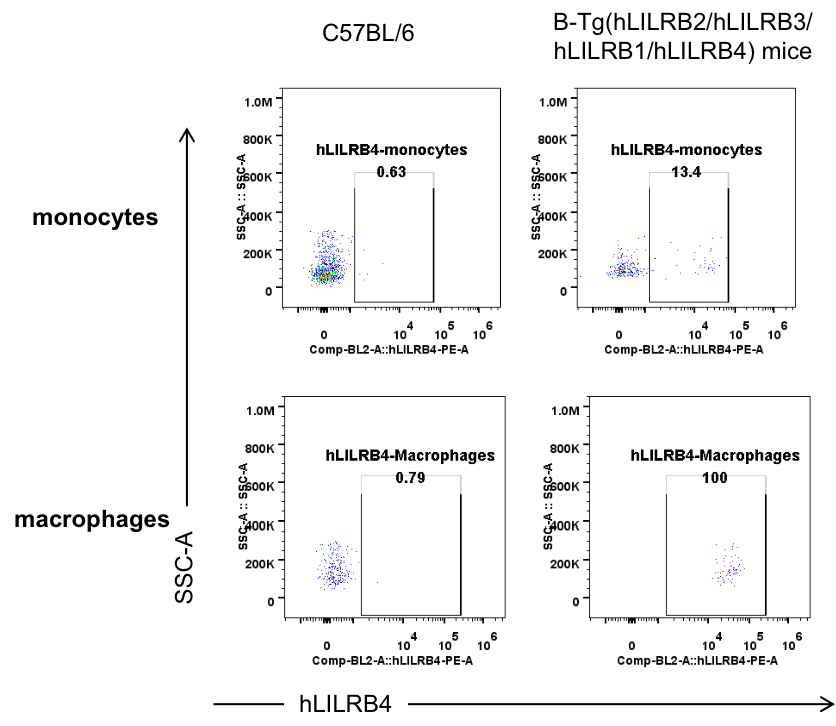
Analysis of leukocytes cell subpopulation in B-Tg(hLILRB2/hLILRB3/hLILRB1/hLILRB4) mice (non-tumor bearing)
Analysis of leukocytes cell subpopulation in spleen

Analysis of spleen leukocyte subpopulations by FACS. Splenocytes were isolated from female C57BL/6 and B-Tg(hLILRB2/hLILRB3/hLILRB1/hLILRB4)mice (n=3, 8-week-old). Flow cytometry analysis of the splenocytes was performed to assess leukocyte subpopulations. A. Representative FACS plots. Single live cells were gated for the CD45+ population and used for further analysis as indicated here. B. Results of FACS analysis. Percent of T cells, B cells, NK cells, dendritic cells, granulocytes, monocytes and macrophages in B-Tg(hLILRB2/hLILRB3/hLILRB1/hLILRB4)mice were similar to those in the C57BL/6 mice, demonstrating that LILRB1, LILRB2, LILRB3 and LILRB4 humanized does not change the overall development, differentiation or distribution of these cell types in spleen. Values are expressed as mean ± SEM.
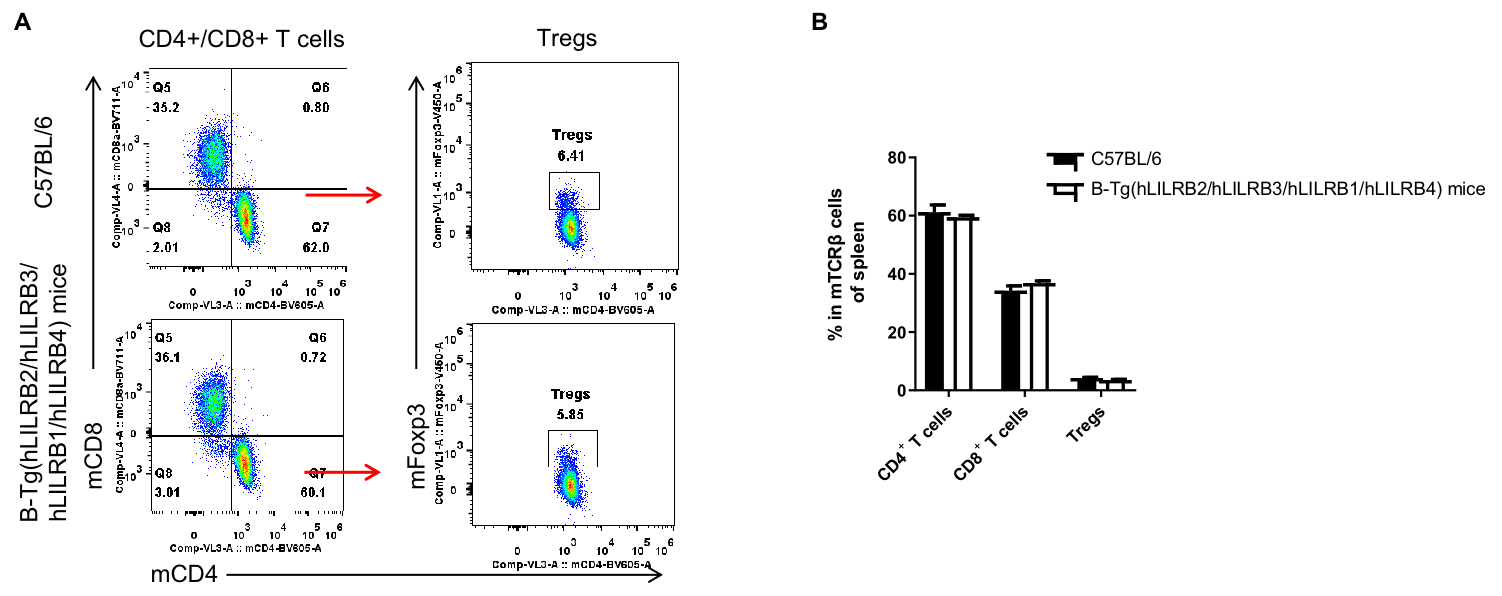
Analysis of spleen T cell subpopulations by FACS. Splenocytes were isolated from female C57BL/6 and B-Tg(hLILRB2/hLILRB3/hLILRB1/hLILRB4)mice (n=3, 8-week-old). Flow cytometry analysis of the splenocytes was performed to assess leukocyte subpopulations. A. Representative FACS plots. Single live CD45+ cells were gated for TCRβ+ T cell population and used for further analysis as indicated here. B. Results of FACS analysis. The percent of CD4+ T cells, CD8+ T cells and Tregs in B-Tg(hLILRB2/hLILRB3/hLILRB1/hLILRB4)mice were similar to those in the C57BL/6 mice, demonstrating that introduction of LILRB1, LILRB2, LILRB3 and LILRB4 does not change the overall development, differentiation or distribution of these T cell subtypes in spleen. Values are expressed as mean ± SEM.
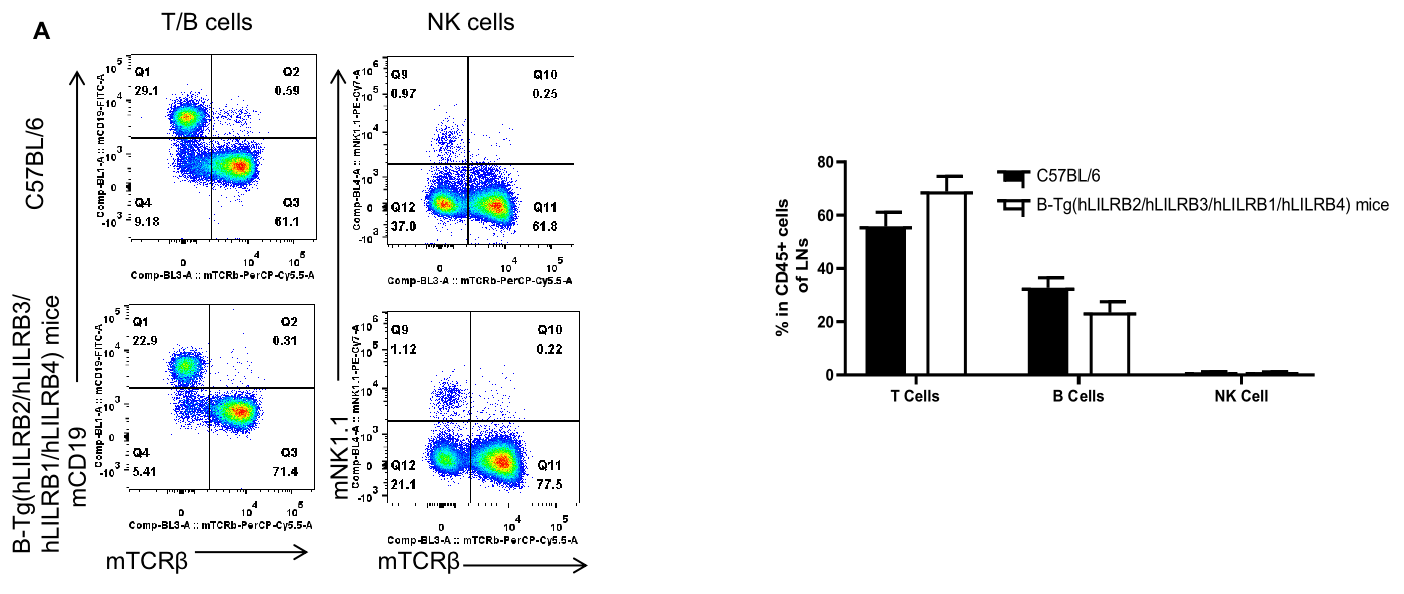
Analysis of thymus leukocyte subpopulations by FACS. LNs (Lymph nodes) were isolated from female C57BL/6 and B-Tg(hLILRB2/hLILRB3/hLILRB1/hLILRB4)mice (n=3, 8-week-old). Flow cytometry analysis of the LNs was performed to assess leukocyte subpopulations. A. Representative FACS plots. Single live cells were gated for the CD45+ population and used for further analysis as indicated here. B. Results of FACS analysis. Percent of T cells, B cells and NK cells in B-Tg(hLILRB2/hLILRB3/hLILRB1/hLILRB4)mice were similar to those in the C57BL/6 mice, demonstrating that LILRB1, LILRB2, LILRB3 and LILRB4 humanized does not change the overall development, differentiation or distribution of these cell types in LNs. Values are expressed as mean ± SEM.
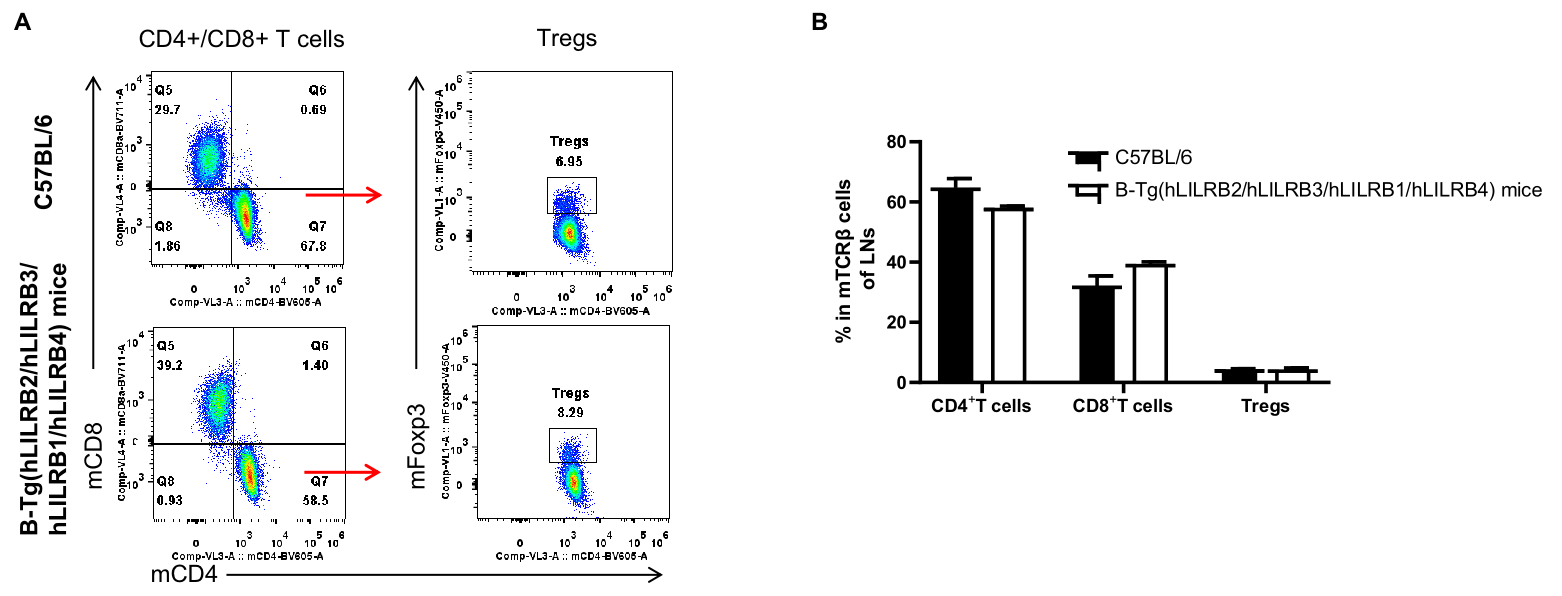
Analysis of thymus T cell subpopulations by FACS. LNs (Lymph nodes) were isolated from female C57BL/6 and B-Tg(hLILRB2/hLILRB3/hLILRB1/hLILRB4)mice (n=3, 8-week-old). Flow cytometry analysis of the LNs was performed to assess leukocyte subpopulations. A. Representative FACS plots. Single live CD45+ cells were gated for TCRβ+ T cell population and used for further analysis as indicated here. B. Results of FACS analysis. The percent of CD4+ T cells, CD8+ T cells and Tregs in B-Tg(hLILRB2/hLILRB3/hLILRB1/hLILRB4)mice were similar to those in the C57BL/6 mice, demonstrating that introduction of LILRB1, LILRB2, LILRB3 and LILRB4 does not change the overall development, differentiation or distribution of these T cell subtypes in LNs. Values are expressed as mean ± SEM.

Analysis of blood leukocyte subpopulations by FACS. Blood leukocytes were isolated from female C57BL/6 and B-Tg(hLILRB2/hLILRB3/hLILRB1/hLILRB4)mice (n=3, 8-week-old). Flow cytometry analysis of the blood leukocytes were performed to assess leukocyte subpopulations. A. Representative FACS plots. Single live cells were gated for the CD45+ population and used for further analysis as indicated here. B. Results of FACS analysis. Percent of T cells, B cells, NK cells, dendritic cells, granulocytes, monocytes and macrophages in B-Tg(hLILRB2/hLILRB3/hLILRB1/hLILRB4)mice were similar to those in the C57BL/6 mice, demonstrating that LILRB1, LILRB2, LILRB3 and LILRB4 humanized does not change the overall development, differentiation or distribution of these cell types in blood. Values are expressed as mean ± SEM.
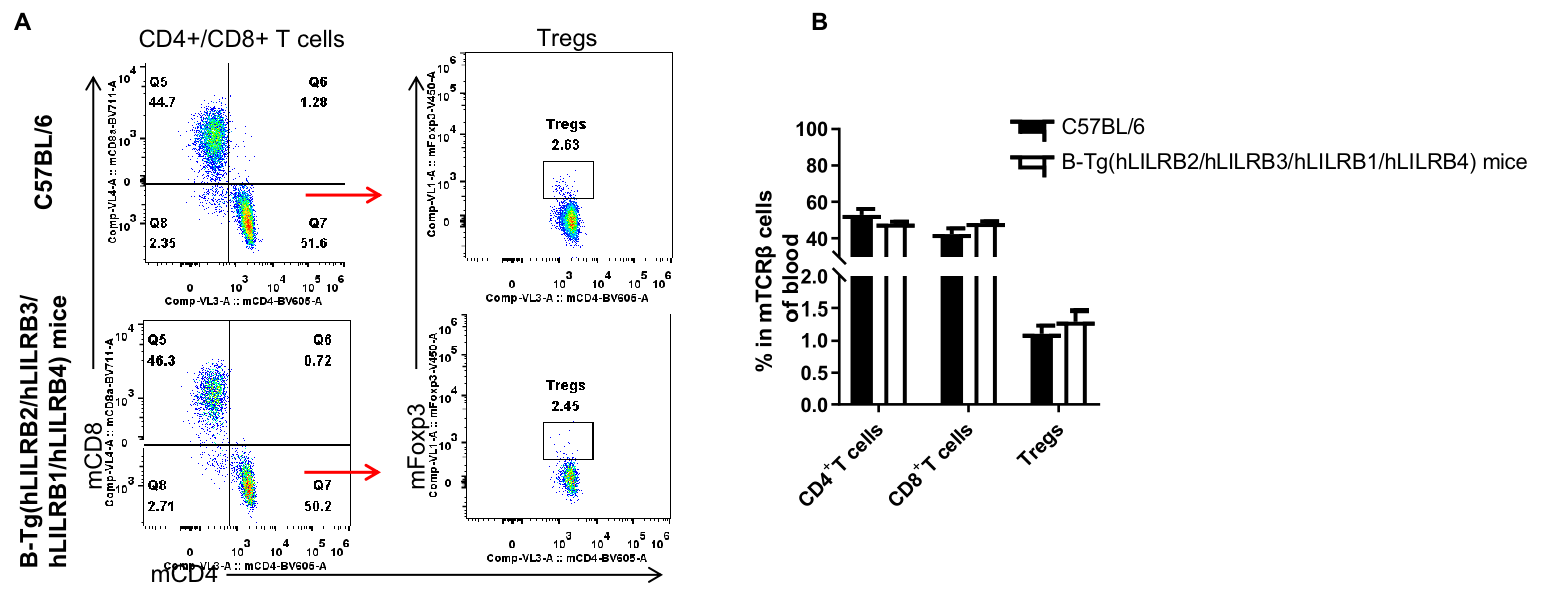
Analysis of blood T cell subpopulations by FACS. Blood leukocytes were isolated from female C57BL/6 and B-Tg(hLILRB2/hLILRB3/hLILRB1/hLILRB4)mice (n=3, 8-week-old). Flow cytometry analysis of the blood leukocytes were performed to assess leukocyte subpopulations. A. Representative FACS plots. Single live CD45+ cells were gated for TCRβ+ T cell population and used for further analysis as indicated here. B. Results of FACS analysis. The percent of CD4+ T cells, CD8+ T cells and Tregs in B-Tg(hLILRB2/hLILRB3/hLILRB1/hLILRB4)mice were similar to those in the C57BL/6 mice, demonstrating that introduction of LILRB1, LILRB2, LILRB3 and LILRB4 does not change the overall development, differentiation or distribution of these T cell subtypes in blood. Values are expressed as mean ± SEM.

Analysis of bone marrow leukocyte subpopulations by FACS. Bone marrow leukocyte were isolated from female C57BL/6 and B-Tg(hLILRB2/hLILRB3/hLILRB1/hLILRB4)mice (n=3, 8-week-old). Flow cytometry analysis of the bone marrow leukocyte was performed to assess leukocyte subpopulations. A. Representative FACS plots. Single live cells were gated for the CD45+ population and used for further analysis as indicated here. B. Results of FACS analysis. Percent of T cells, B cells, NK cells, dendritic cells, granulocytes, monocytes and macrophages in B-Tg(hLILRB2/hLILRB3/hLILRB1/hLILRB4)mice were similar to those in the C57BL/6 mice, demonstrating that LILRB1, LILRB2, LILRB3 and LILRB4 humanized does not change the overall development, differentiation or distribution of these cell types in bone marrow. Values are expressed as mean ± SEM.
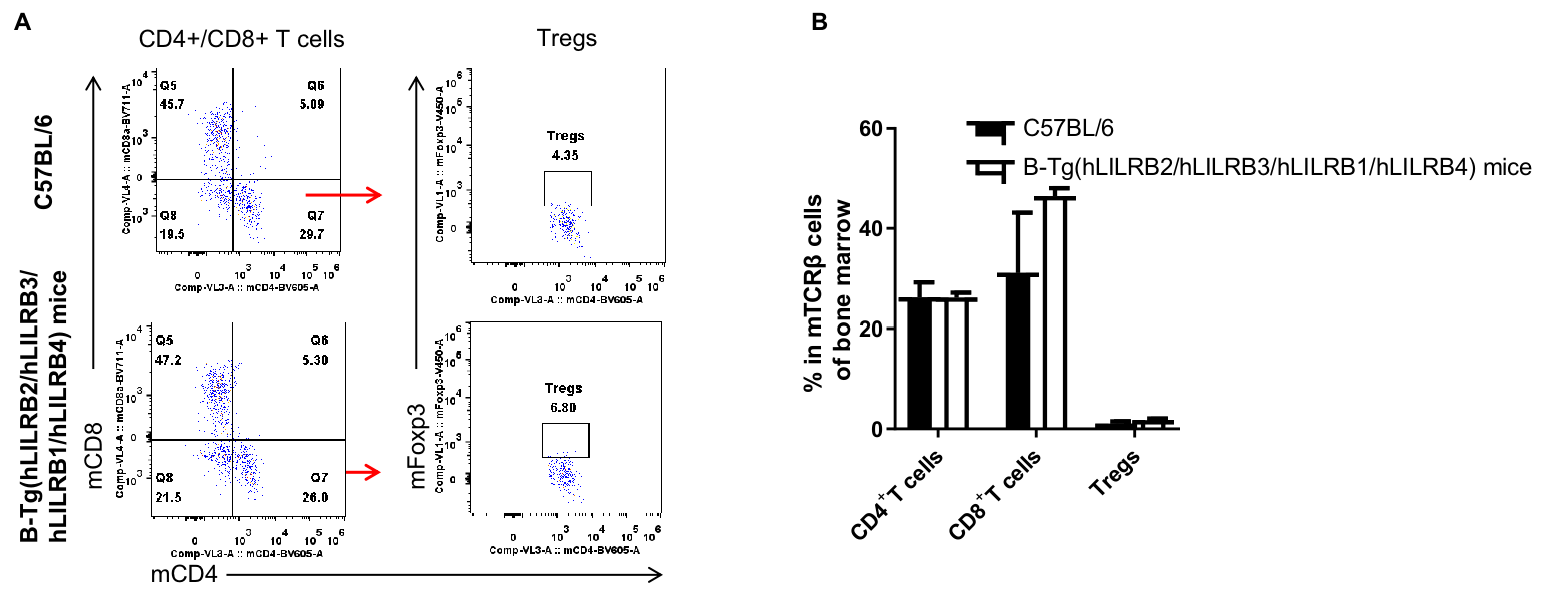
Analysis of bone marrow T cell subpopulations by FACS. Bone marrow leukocyte were isolated from female C57BL/6 and B-Tg(hLILRB2/hLILRB3/hLILRB1/hLILRB4)mice (n=3, 8-week-old). Flow cytometry analysis of the bone marrow leukocyte was performed to assess leukocyte subpopulations. A. Representative FACS plots. Single live CD45+ cells were gated for TCRβ+ T cell population and used for further analysis as indicated here. B. Results of FACS analysis. The percent of CD4+ T cells, CD8+ T cells and Tregs in B-Tg(hLILRB2/hLILRB3/hLILRB1/hLILRB4)mice were similar to those in the C57BL/6 mice, demonstrating that introduction of LILRB1, LILRB2, LILRB3 and LILRB4 does not change the overall development, differentiation or distribution of these T cell subtypes in bone marrow. Values are expressed as mean ± SEM.











